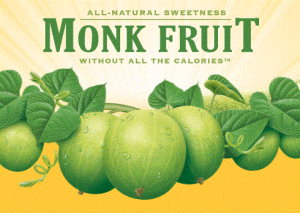 Monk fruit is new on the market (being sold as monk fruit). It has been used for some time in products under its Chinese name “luo han guo” or “luo han fruit.” The makers of Splenda make product called Nectresse – which is supposed to be Monk Fruit, but it isn’t. It is mostly erythritol. This follows the same investigating that I did into seemingly healthy alternative sweeteners made from stevia Pure Via and Truvia, among others, that are over 90% erythritol.
Monk fruit is new on the market (being sold as monk fruit). It has been used for some time in products under its Chinese name “luo han guo” or “luo han fruit.” The makers of Splenda make product called Nectresse – which is supposed to be Monk Fruit, but it isn’t. It is mostly erythritol. This follows the same investigating that I did into seemingly healthy alternative sweeteners made from stevia Pure Via and Truvia, among others, that are over 90% erythritol.
For the companies that are trying to make a natural In the Raw version of Monk Fruit, I was not entirely convinced that these companies are going through a three step process to create this product. Here’s how they explain it on Monk Fruit In the Raw, grown by BioVittoria in New Zealand.
Crush – The fruit is crushed to release its natural sweet juice
Infuse – The crushed fruit is mixed with hot water to make a sweet infusion
Filter – The infusion is filtered, leaving a clear, fresh juice which contains the sweet anti-oxidants and a small amount of natural fruit sugar. To make monk fruit powder, the fruit sugar is separated from the sweet anti-oxidants which are then spray dried to a fine milk-white powder.
This sounds so natural – doesn’t it? I looked it up on the FDA submissions for GRAS (generally recognized as safe) and here is the process
(Simply put – this is not a real food. I don’t recommend it)
http://www.accessdata.fda.gov/scripts/fcn/gras_notices/grn000301.pdf
This is the way that it is produced: I bolded a resin that is used below – used in polyester resins: Divinylbenzene (DVB) consists of a benzene ring bonded to two vinyl groups. It is related to styrene (vinylbenzene) by the addition of a second vinyl group
1.5.4. Processing of Luo Han Fruit Concentrate
Processing methods are generally similar to those used to produce a number of other fruit-derived products. The fresh fruit is mechanically crushed or shredded. Macerated fruit is decocted for 30-40 minutes at 80°C with deionized water.. The supernatant is allowed to cool to 50°C and is then clarified by passing through an ultrafiltration membrane to remove the large molecules of protein and pectin fiom the Supernatant. The supernatant is then passed through a pressurized resin-packed column.
The resin is a divinylbenzene copolymer, a macroporous polymeric adsorbent which removes organic substances fi-om aqueous flows. The resin achieves its effect by electrostatic site-specific attraction, binding the target compounds, principally mogrosides, while allowing unwanted compounds, including remaining traces of reducing sugars and mineral salts, to pass through into the waste stream. The action of the resin is mechanical rather than chemical and can best be compared to sieving or straining. Supernatant is continuously introduced into the columns until the binding surface of the resin (approximately 100-1000 m2/g) is fully saturated.
After the mechanical separation of components of the supernatant has been effected by the resin, the adhered material is released from the resin by elution with successive increments of food-grade aqueous ethanol solution. This process frees virtually all of the adsorbed material from the resin. The ethanol solution does not chemically change any of the compounds but merely brings them into solution. The eluent is heated to approximately 60°C and placed under partial vacuum, allowing the ethanol and bound water vapor to be condensed and recycled. The mother liquor is then cooled to approximately ambient temperature. It is then subjected to a decolorizing step to separate the terpene glycosides in the solution from the melanoidins and other nonterpene glycoside molecules. This is achieved by contacting the mother liquor with a styrene &vinylbenzene resin that adsorbs the colored melanoidin compounds and other non-terpene glycoside molecules in the solution. The decolorized mother liquor is then concentrated to approximately 40% soluble solids and spray-dried at 120°C in enclosed conditions, removing any remaining water and ethanol. After cooling to ambient temperature, the powder is sampled for analysis and sealed in Mylar-coated aluminum bags.
At the end of each run, the resin is regenerated by flushing with a food-grade 0.2% solution of calcium hydroxide, followed by filtered water. Next, a food-grade 0.2% solution of hydrochloric acid is introduced to restore the neutral pH of the resin. Finally, the column is flushed with filtered water.
Enjoying this content? Sign up for updates... It's FREE!




Comments
from 1 people
Thanks a lot for the article post. Cool. Reveal
WilliamApef
Leave A Comment